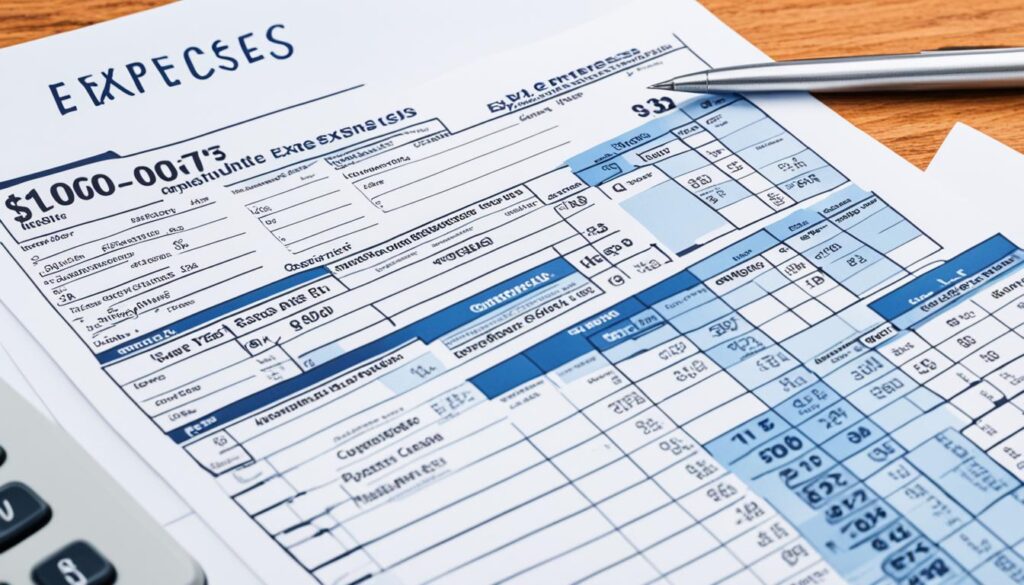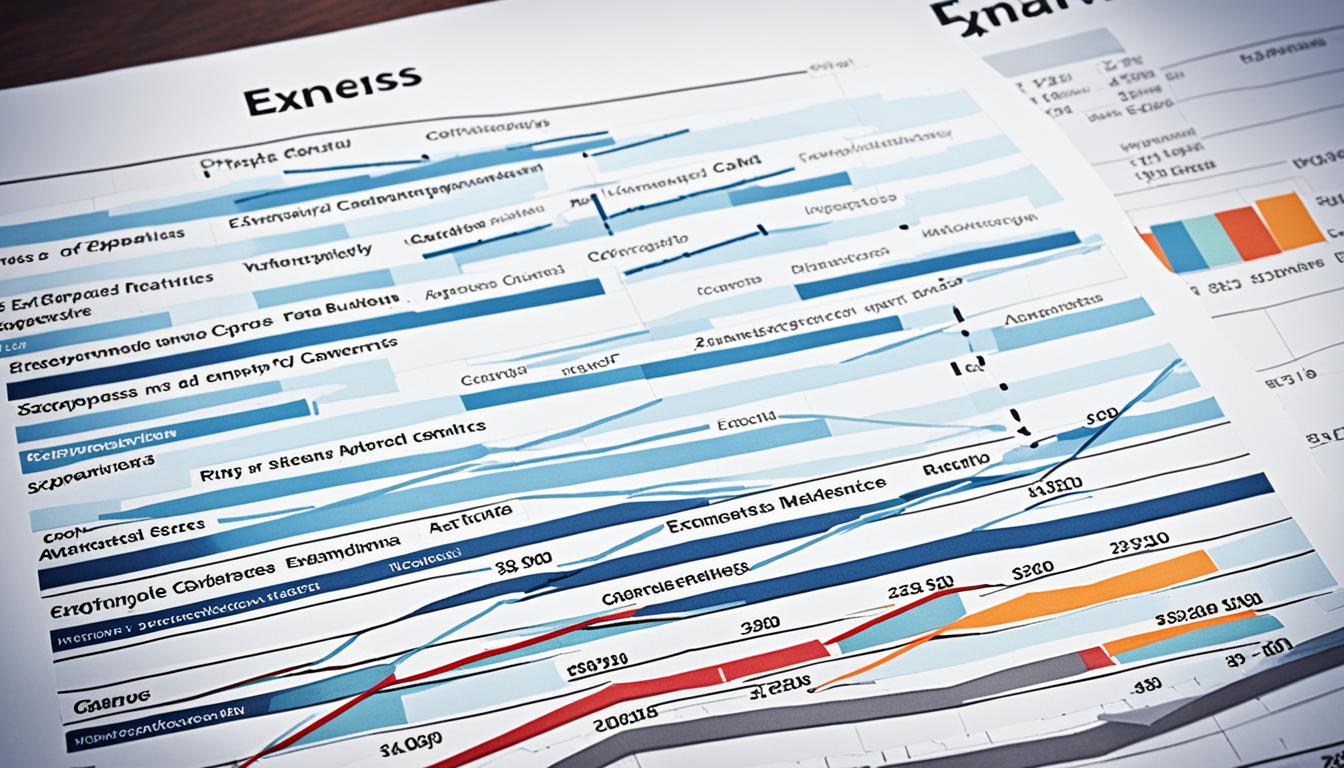Did you know that small businesses in the United States spend an average of $30,000 to $50,000
Starting and running a business involves various expenses that need to be carefully managed. Tracking and understanding these costs is crucial for effective financial planning and tax management. Business expenses include both fixed expenses, such as rent and insurance, and variable expenses like sales commissions and shipping costs. By categorizing and tracking these expenses, businesses can better monitor their financial health and optimize their operations.
Key Takeaways:
- Small businesses in the United States spend an average of $30,000 to $50,000 annually on operating expenses.
- Business expenses include both fixed and variable costs.
- Tracking and categorizing expenses is crucial for financial planning and optimization.
Understanding Business Expenses and Deductibility Criteria
Business expenses are an integral part of operating a business, and understanding the criteria for deductibility is essential for effective tax management. According to the IRS, for an expense to be tax-deductible, it must meet the criteria of being both ordinary and necessary.
Ordinary expenses: Ordinary expenses are commonly incurred and accepted in a particular industry. These expenses are considered normal and expected within the context of the business’s operations.
Necessary expenses: Necessary expenses are deemed essential for the business’s operations. They are expenses that a prudent business owner would incur to maintain the business’s efficiency, productivity, and profitability.
The IRS provides guidelines on deductibility criteria for different types of expenses. By understanding these guidelines and ensuring their expenses meet the criteria, businesses can take advantage of tax deductions and reduce their tax liability.
“Understanding the criteria for deductibility is crucial for businesses’ financial planning and tax compliance. By categorizing and tracking expenses that meet the IRS guidelines, businesses can optimize their tax-deductible expenses and minimize their tax burden.” – IRS spokesperson
Having a clear understanding of what qualifies as a tax-deductible expense can help businesses plan their finances effectively, allocate resources efficiently, and make informed decisions to maximize tax savings. Proper documentation and record-keeping are vital to substantiate these expenses in the event of an audit or tax review.
Here is a table outlining some common examples of tax-deductible business expenses:
| Expense Category | Examples |
|---|---|
| Advertising and Marketing | Online ads, print media, social media marketing |
| Payroll Expenses | Employee wages, salaries, bonuses, payroll taxes |
| Office Supplies | Stationery, pens, paper, printer ink |
| Utilities | Electricity, water, gas, internet |
It is important for businesses to consult with a tax professional or refer to the official IRS guidelines to ensure their expenses meet the necessary criteria for deduction. By doing so, businesses can optimize their tax deductions, reduce their tax liability, and ensure compliance with applicable tax laws and regulations.
Examples of Deductible Business Expenses
When it comes to running a business, it’s essential to understand which expenses can be deducted to minimize your tax liability. Here are some common deductible business expenses:
- Advertising Expenses: These include costs related to marketing campaigns, promotions, and online advertising.
- Payroll Expenses: This category covers salaries, wages, bonuses, commissions, and other compensation paid to employees.
- Office Supplies: Expenses for stationery, paper, ink, pens, and other necessary office supplies are considered deductible.
- Utilities: Costs for electricity, water, gas, internet, and telephone services used for business purposes can be deducted.
Additionally, there are other deductible expenses that can vary depending on your specific business needs, such as:
- Bank fees and interest
- Business mileage
- Commissions
- Employee benefits
- Equipment maintenance
- Insurance premiums
- Legal fees
- Rent or office lease
- Software expenses
Image:

It’s important to note that to claim these deductible expenses, you must keep proper documentation and ensure they meet the IRS’s guidelines for deductibility. By carefully tracking and categorizing your business expenses, you can maximize your deductions while staying compliant with tax regulations.
“Understanding deductible business expenses is key to optimizing your tax returns and reducing your overall tax liability.”
Examples of Deductible Business Expenses
| Expense Category | Examples |
|---|---|
| Advertising Expenses | Marketing campaigns, online advertising, promotions |
| Payroll Expenses | Salaries, wages, bonuses, commissions |
| Office Supplies | Stationery, paper, ink, pens |
| Utilities | Electricity, water, gas, internet, telephone services |
| Bank fees and interest | Transaction fees, interest on business loans |
| Business mileage | Mileage expenses for business-related travel |
| Commissions | Commissions paid to sales representatives |
| Employee benefits | Health insurance, retirement plans, vacation pay |
| Equipment maintenance | Repair costs for office equipment and machinery |
| Insurance premiums | Business insurance coverage |
| Legal fees | Costs for legal advice and services |
| Rent or office lease | Rental expenses for office space |
| Software expenses | Licensing fees, subscriptions |
Managing and Tracking Business Expenses
Properly managing and tracking business expenses is essential for financial planning and tax compliance. By implementing effective expense management strategies, businesses can optimize their spending, identify cost-saving opportunities, and ensure accurate reporting. Here are some essential tips for managing and tracking business expenses:
1. Record-keeping
Keeping meticulous records of all business expenses is crucial for accurate tracking and reporting. Maintain a systematic record-keeping system that includes receipts, invoices, and other relevant documentation. This will help you keep track of your expenses, categorize them appropriately, and provide evidence in case of an audit. It is recommended to retain these records for at least 3-7 years, depending on the nature of the expense.
2. Separate Personal and Business Expenses
To simplify expense tracking and maintain financial clarity, it is essential to separate personal and business expenses. Establish a dedicated business bank account and use it exclusively for business-related transactions. This separation will not only streamline your expense management process but also contribute to accurate financial reporting.
3. Utilize Accounting Software
Implementing accounting software can significantly simplify and streamline your expense management process. These software solutions offer features such as expense tracking, receipt scanning, and automated categorization. They can generate detailed expense reports, provide real-time insights into your financial health, and streamline tax preparation.
4. Regular Expense Review
Regularly reviewing your business expenses is critical for optimizing your operational costs. Analyze your expense trends, identify any unnecessary or excessive spending, and look for areas where you can reduce costs. Consider negotiating better deals with suppliers, exploring alternative vendors, and leveraging technology to automate certain processes.
“Efficient expense management helps businesses maintain a healthy cash flow, reduce unnecessary spending, and optimize their operations.”
By implementing these expense management tips and consistently tracking your business expenses, you can ensure good financial health and maximize your profitability. Regular expense review and analysis allow you to identify areas for cost savings, make informed business decisions, and allocate resources efficiently. With proper management, your business can stay on top of its finances and achieve long-term success.
![]()
Conclusion
Effective expense management and optimizing business expenses are essential for reducing operating costs and ensuring the financial health of a business. By understanding and categorizing expenses, businesses can make informed decisions to minimize unnecessary spending and maximize cost-saving opportunities.
Proper tracking and documentation of expenses are crucial for accurate financial reporting and tax compliance. By maintaining meticulous records and regularly reviewing expenses, businesses can identify areas for improvement and implement strategies to minimize waste and increase efficiency.
Businesses should prioritize effective expense management by separating personal and business expenses, opening a dedicated business bank account, and utilizing accounting software for streamlined tracking and analysis. Regularly monitoring financial health and implementing cost-saving measures will enhance profitability and contribute to the long-term sustainability of the business.
FAQ
What are business running costs examples?
Business running costs examples include rent, insurance, sales commissions, and shipping costs. These are expenses incurred in the day-to-day operations of a business.
How do I determine if a business expense is tax-deductible?
To be tax-deductible, a business expense must meet the criteria of being both ordinary and necessary. It should be a common expense accepted in your industry and considered essential for your business operations. The IRS provides guidelines on deductibility criteria for different types of expenses.
What are some examples of deductible business expenses?
Some common deductible business expenses include advertising and marketing costs, bank fees and interest, business mileage, commissions, employee benefits, equipment maintenance, insurance premiums, legal fees, office supplies, payroll expenses, rent or office lease, software expenses, and utility costs.
How should I manage and track my business expenses?
It is important to maintain meticulous records of your business expenses, including receipts and other documentation. Keep separate records for at least 3-7 years, depending on the type of expense. It is recommended to open a dedicated business bank account and use accounting software for efficient expense management. Regularly review your expenses and monitor your financial health to identify areas for cost savings and optimization.
Why is managing and controlling business expenses important?
Managing and controlling business expenses is crucial for the financial health and success of your business. By understanding and categorizing your expenses, you can make informed decisions to reduce operating costs, optimize spending, and maximize tax deductions. Proper tracking and documentation of expenses, along with regular review and analysis, can help you identify areas for improvement and implement strategies for effective expense management. This can enhance your profitability and long-term sustainability.


